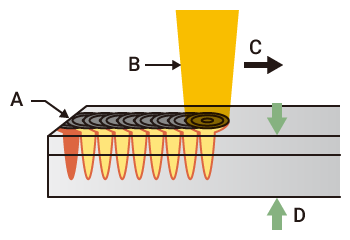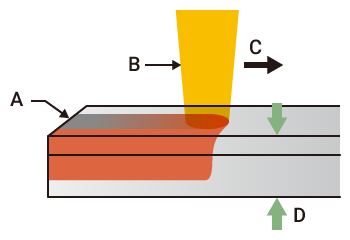Difference between gas lasers, solid-state lasers, and semiconductor lasers
Lasers used for laser welding employ gas, a solid object, or a semiconductor as the medium.
The oscillation form, output, and conversion efficiency of the laser beam output by each medium vary.
The following section takes a closer look at the features of each medium while also explaining the oscillation form, which is a major factor in laser welding.
Laser beam differences between mediums
The following table shows the differences in oscillation form, output, and conversion efficiency between each medium.
| Oscillation form (P: Pulse, CW: Continuous wave) | Output (P: Pulse, CW: Continuous wave) | Conversion efficiency (%) | ||
|---|---|---|---|---|
| Gas laser | CO2 |
|
|
|
| Solid-state laser | YAG |
|
|
|
| Semiconductor lasers | GaAs (gallium arsenide phosphide) InGaAsP (indium gallium arsenide) |
|
|
|
Oscillation forms
The oscillation form of a laser can be either pulsed or continuous. Pulse oscillation lasers generate a pulse wave by controlling (through light modulation) the intensity, wavelength, and phase of the laser beam. Methods for generating a pulse also include controlling the Q value of the laser oscillator as with Q-switch lasers. The “Q value” is the ratio of energy consumed in each cycle to the accumulated energy. This value can be expressed by the following formula.
Q = (2π / Accumulated energy) / (Energy consumed per cycle)
The shape of the weld bead also varies for each oscillation form, as shown below.
Pulse oscillation (P)

Continuous wave (CW)

- A
- Weld bead
- B
- Laser beam
- C
- Beam movement
- D
- Pressure
Solid-state laser
A solid-state laser uses ore such as yttrium, aluminum, and garnet (YAG) or yttrium vanadate crystal (YVO4) as the laser medium. Because solid-state lasers have a large laser output per unit volume, a large laser output is possible even with a small resonator.
Solid-state laser

- A
- Full reflector
- B
- Laser beam
- C
- Excitation light source (lamp, LD)
- D
- YAG crystal
- E
- Partial reflector
- F
- Lens
- G
- Optical fiber
- H
- Lens
- I
- Workpiece
Gas laser
A gas laser uses a gas such as CO2 as the laser medium. Compared with solid-state lasers or other laser mediums, a gas medium is more uniform with less loss, and the resonator can be larger to allow for larger laser output.
Gas laser

- A
- Full reflector
- B
- Electrode
- C
- Laser gas
- D
- Partial reflector
- E
- Laser beam
- F
- Metal mirror
- G
- Lens
- H
- Workpiece
Semiconductor lasers
Semiconductor lasers use III-V semiconductors or IV-VI semiconductors for the laser medium. Both semiconductor types ensure device compactness while also offering a large laser output. Although semiconductors are solid objects, they are sometimes classified separately from solid-state lasers in laser technology fields.




